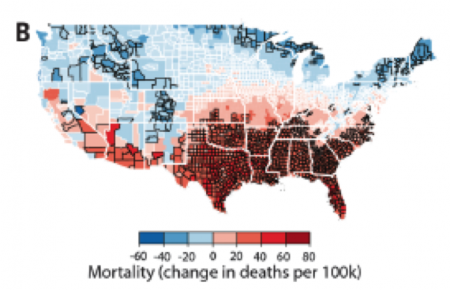Your cool roof helps save lives during heat waves.
Heat kills more people than any other natural disaster, and heat-related deaths tend to be underreported. Cities on dangerously hot days experience 7-14% spikes in mortality from all causes.
Heat kills, on average, more than 1500 people in the U.S. each year, more than any other weather-related disaster. The urban heat island phenomenon, caused by the prevalence of dark, impermeable surfaces and a relative lack of vegetation, makes cities particularly susceptible to the dangers of extreme heat. Studies like the Li and Bou-Zeid 2013 show that heat waves not only increase ambient temperatures, but they also intensify the difference between urban and rural temperatures. As a result, the added heat stress in cities will be even higher than the sum of the background urban heat island effect and the heat wave effect. The study also attributes this added impact of heat waves on urban areas to the lack of surface moisture in urban areas and the low wind speed associated with heat waves.
Given that heat waves are projected to become more frequent and that urban populations are substantially increasing, these findings underline the serious heat-related health risks facing urban residents in the twenty-first century. While there are specific heat-related causes of death that coroners may use, they represent a very small percentage of deaths from other causes that heat exacerbates. When looking at so-called “all cause” mortality, a clear trend of higher than average deaths appears on days when conditions are dangerously hot. In a sampling of U.S. cities done in Kalkstein et al, dangerously hot days were associated with 7-14% increases in total mortality.
The number of these dangerously hot days and heat emergencies is increasing every year across the country.
Many of our communities are experiencing significantly more extreme heat days and, in general, urban areas are heating up at twice the global average rate of warming. One study, Heat in the Heartland: 60 Years of Warming in the Midwest, finds that cities are experiencing more multi-day heat waves and those oppressive days have gotten 4–5°F (2-3°C) hotter and more humid than in decades past. These heating trends are also affecting nighttime temperatures, which are critical in reducing heat stress and heat-related illness.

A new study in the Journal Science of the impact of rising heat on the U.S. finds that heat’s mortality effects will be regionally specific. Texas and the Southeastern states will bear the overwhelming impact of increased mortality from heat (see image from the study above)
Studies show that installing cool roofs and vegetation can lead to a meaningful reduction in heat deaths by making the daytime weather conditions more tolerable. One study found that a realistic, 10%, increase in reflectivity and vegetation could reduce heat wave deaths by 6%.
There are a number of studies estimating the impact of increasing urban reflectivity and vegetative cover on weather conditions. Kalkstein 2012 and Vanos 2013 looked at past heat waves in 4 U.S. cities and modeled the impact of increasing reflectivity by 0.1 (the equivalent of switch about 25% of roofs from dark to light colors) and vegetative cover by 10%. They found that even these modest changes could shift weather into less dangerous conditions and save lives.
In a comprehensive literature review on this topic, Santamouris 2012 found that when a global increase of the city’s albedo is considered, the expected mean decrease of the average ambient temperature is close to 0.5°F (0.3°C) per 0.1 increase in reflectivity, while the corresponding average decrease of the peak ambient temperature is close to 1.6°F (0.9°C).